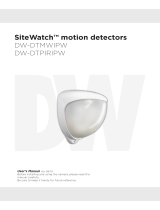Page is loading ...

IP65, Suitable
for outdoor use
Masking protection
to prevent intruder
tampering
Dualtech sensor
for reliable alarm
detection
Temperature
compensation for
extreme environments
Detection range
selectable
3m - 12m
PACKAGE CONTENTS
• 1 x Pearl body
• 1 x T-bracket assembly
• 4 x wall plugs
• 4 x wall xing screws
• 1 x drilling template
• 1 x opening tool
INTRODUCTION
The Pearl Detector is an outdoor motion detector with dual
detection technology and anti-masking that uses PIR and
microwave detection.
Both sensors must trigger to cause the detector to alarm
ensuring precise and reliable presence detection. The
detector has three N/C outputs for alarm, masking and
tamper triggering.
QUICK INSTALLATION
1. Mount the detector following the instructions in
sections “Mounting the Unit” and “Detector Placement
and Beam Pattern”.
2. Power the unit and ensure switch 1 is set to ON. The
unit will ash for two minutes during this time. Fit the
front cover on the unit and when the unit has nished
ashing it will be ready for walk testing.
MOUNTING THE UNIT
During installation, protect the electronics against water as
trapped moisture can affect or damage the unit.
BASIC INSTALLATION, BEAM OUTWARD FROM
SURFACE (see gures 2,3,11,13)
1. Use drilling template to locate the two mounting holes
(A gure 2).
2. Next feed the cable through rear or side knock-outs
and then x to the wall (B & C gure 2).
INSTALLATION WITH T-BRACKET ASSEMBLY, BEAM
ACROSS SURFACE (see gures 4,5,12,14)
1. Use drilling template to locate the four mounting
holes (A gure 4).
2. Next feed the cable through rear or side knock-outs (
B gure 4) and out through cable access point. Fix to
the wall and then secure the blanking plate onto the
unused side of the T-bracket (gure 5,15).
FRONT ASSEMBLY (see gure 6-10)
1. Feed cable through grommet. Clip middle section
shown into lower part of back section (gure 8) push
back until at to wall. Cut and wire the cable into the
terminal blocks (gure 6,7)
2. Push the bottom of the front cover into clip on the
middle section and rotate back at to the wall (gure
8). Secure by tightening the screw in access hole.
Finally push t screw cover.
3. To access the unit once installed rst lever off the
screw cover (see gure 9). Unscrew the screw in the
access hole. Next reverse steps shown in (gure 8)
or to remove from the wall use provided clip to lever
off the wall mounting (see gure 10).
DETECTOR PLACEMENT AND BEAM PATTERN (see
gure 12 -15)
The detector uses microwave and infrared sensing to
determine motion detection. The optimum position of the
detector should be chosen to detect an intruder crossing
the beam pattern (gure 13), and to avoid trafc from roads
and paths (gure 14).
For applications where the T-bracket is used ensure the
angle of the detector is pointing 2° away from the building
(gure 15).
The detector should be at an optimum height of 2-2.5m.
Secure the detector to a wall or solid xture.
Two detectors must not be tted back to back on the
T-bracket. A minimum space of 2 metres must be left
between detectors.
PROGRAMMING
The detector can be programmed with different range
and sensitivity options and also LED indication. This can
be done by changing the four DIP switch settings on the
detector PCB (see gure 6). The range can be set to 3, 6, 9
or 12m and the sensitivity can be changed to high or low.
WALK TEST
Set the LED Indication to Enabled (gure 6). On power up
the LED will ash red and green alternately for 2 minutes.
The detector will then indicate an alarm condition with a
red LED.
The alarm detection will ash red for 1s with an interval of
5s between detections when LED indication is ON.
The masking condition is indicated with a continuous green
led indication when LED indication is ON.
MASKING OUTPUT
A masking event will be triggered after 60s of masking of
the lens. The masking output will be cleared by removing
the masking object. To re-calibrate the masking reset
power to the device or change a DIP setting and replace
the cover and allow to calibrate.
Pearl
GJD140 Curtain Beam Detector
Detect.Illuminate.Dete
r

SPECIFICATIONS
Part Number GJD140 - GJD141 Silver
GJD140/W -GJD141/W White
Detection selectable
range
3m 6m 9m 12m
Normally Closed
Alarm
50mA 24Vdc Alarm time 10s
Normally Closed
Masking
50mA 24Vdc
Normally Closed
Tamper
with 20Ω impedance 50mA
Power input 12V +/- 3V @ max 40mA
*During installation the DC supply fault current shall
be limited to a maximum of 1A
Operating
temperature
-20°C to +55°C
Temperature
compensation
Digital
Microwave
Frequencies
GJD 140 10.587GHz,
GJD 141 10.525GHz
Maximum Beam
Pattern Area
12 x 2m
Dimensions 117mm[h] x 44mm[w] x
41mm[d]
T-Bracket 120mm[h] x 68mm[w] x
50mm[d]
Boxed 125mm[h] x 93mm[w] x
58mm[d]
Weight 139g
Packed weight 201g
Cable (<200m) 8 core 7/0.2mm
Walk Test Using LED Indication
Recommended
Mounting Height
2 - 2.5 m
Swivel Bracket
Accessory
GJD149 - Silver
GJD149/W - White
Certications
1
2
C
A
B
A

3 4
B
AA
5

7
8
RANGE
3 metres 6 metres
9 metres 12 metres
SENSITIVITY
Low
Sensitivity
High
Sensitivity
LED INDICATION
Disabled Enabled
9-15V DC
<24V DC
50 mA, (N/C)
<24V DC
50 mA, (N/C)
<24V DC
50 mA, (N/C)
Detector
2
1
2
1
11
012m
Side View
012m
2m
Top View
6
9
10

12
Side View
Top View
13
14
15
-2-

Unit 2, Birch Business Park, Whittle Lane, Heywood, Greater Manchester, OL10 2SX, UK
w: www.gjd.co.uk t: +44 (0) 1706 363 998 f: +44 (0) 1706 363 991
ENGINEER NOTES
/










